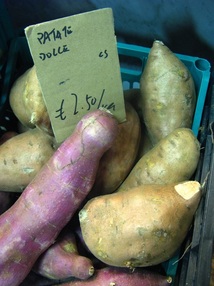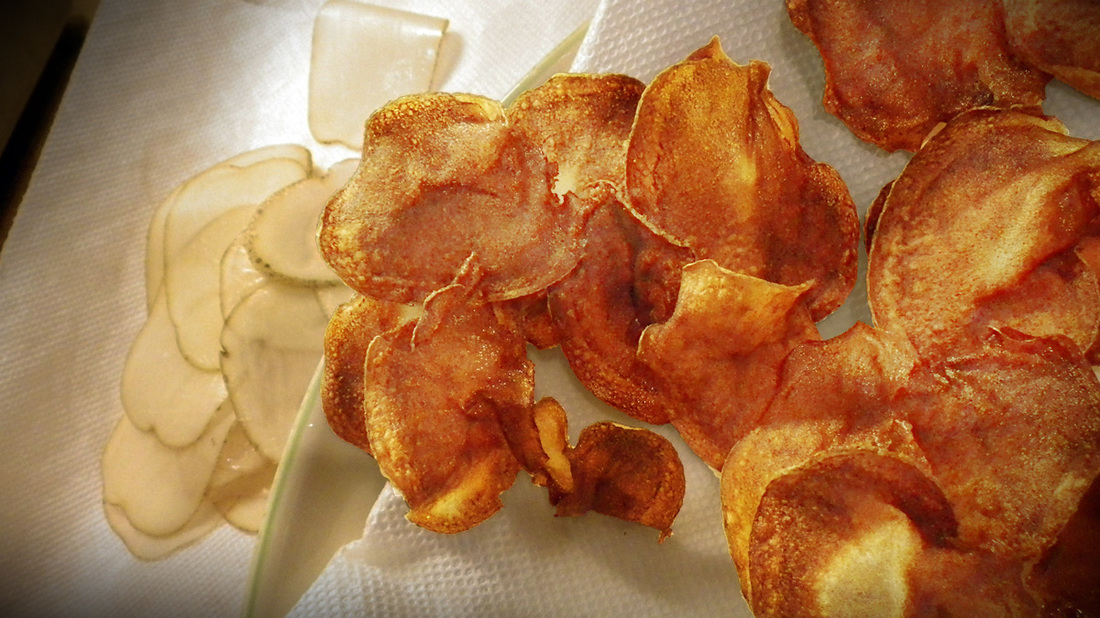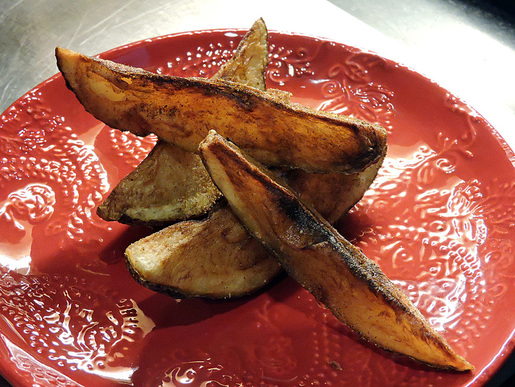Recipes: Patate Fritte a Sfoglia (Potato Chips) and Patate Fritte Rustica (Rustic French Fries)10/3/2016 In Italy, there are indeed "French fries", as there are all over the world at this point. Years ago when I took a French language course, my teacher, who professed to be an expert of everything French, told me that there were, in fact, no "French fries" in France--it was an American thing. Yea, right. Of course, when I traveled 3000 miles around France on a moped, I learned something about French life--they certainly did have fries there... only they called them "frittes". (The same "teacher" also suggested that I would never see turkey on a menu--even though the French have great dinde {turkey} dishes--and that corn is only reserved to feed the pigs. Googling "recettes de maïs" will find over 60 million hits for "corn recipes".) Steak-frittes was something that I grew to detest, as it was the low rent district of French cuisine--as common as a burger cooked on a flat-top in an American diner. I spent the unfortunate week on the Cote d'Atlantique stuck in a seaside hotel during a five-day deluge, with a room on the court just above the kitchen where pretty much all they cooked was steak-frittes. I couldn't stand the smell of a deep fryer and "frittes" for decades after that. But of course, life goes on, things change... I learned to be a fairly good cook, and eventually learned to deep-fry, although I tend to reserve deep-frying for special occasions (I'm into heart-healthy eating). If I learned to make "french fries", I was determined to learn the best way to make them--crispy, not greasy, using a heart-healthy fat like canola oil. I've also been a long-time fan of home-made potato chips when served in a restaurant or a great roadside fast food stand. This was another goal when learning to deep fry... Over the course of the last couple of years, I have learned to make both rustic style potato fries and potato chips. In Italian, "French fries" translates as patate fritte (literally, fried potatoes). "Potato chips" can translate rather technically as patate fritte a sfoglia (literally, fried puff pastry potatoes), or chips di patate. In reality, you can just call them "chips" with an Italian accent (pronounced "keeps"). So first, I thought I would share with you how to make my fantastic, twice-fried Patate Fritte Rustica (modeled after the "Famine Fries" I've enjoyed at Celtic festivals... Ok, so call me a universal kind of guy). Patate Fritte Rustica (Makes about 4-6 servings) Ingredients 3 large Idaho style baking potatoes, washed & dried, with the skin on 1 gallon of canola oil for frying Spicing Your choice (to taste) of: Sea salt & fresh ground pepper Old Bay brand spice for an authentic, New England flavor, sprinkle a bit of malt vinegar & salt Italian spice mixture (sea salt, dried oregano, dried basil, crushed red pepper flakes) You may use either an electric deep fryer or a large stock pot to fry your potatoes. If using an electric fryer, follow instructions and be careful not to overfill higher than the oil level lines inside the fryer). If you use a stock pot, you only need to fill with oil to a dept of about 2-3" to safely fry your potatoes. Be VERY careful with hot oil! Never overload your oil with potatoes, and NEVER add wet potatoes or you might have spatter and a boil-over!
 The Potato and Italy The potato is a recent addition to the European cuisine, ever since the Spaniards brought back potatoes from the New World in the 15oos. They are grown and eaten all over Europe and the rest of the world today, with Italy both growing and consuming about 20% less than the United States. It's a wonder that potatoes are grown in the Mediterranean climate of Italy since they were originally brought back from the high altitude of the Andes. It's even more amazing that most of Italy's production of potatoes takes place in the southern part of the country--Campania, Sicily and Puglia. A more interesting fact is that the potato is Italy's second largest crop, right behind the tomato.  My boy, Lucas, learning how to make a great chip My boy, Lucas, learning how to make a great chip Chips di Patate (Makes about 4-6 servings) Ingredients 3 large Idaho style baking potatoes, washed and dried, with the skin on. 1 gallon of canola oil for frying Spicing You have the same options for spicing your chips as in the recipe for Patate Fritte Rustica above. Use either a large stock pot or electric deep fryer for frying your chips. You will also need a mandoline for thinly slicing your potato chips. (Caution when using a mandoline!)
That's all there is to it. I hope you try both recipes... let us know how they turned out. Here's a couple of tips:
Ciao e buon appetito! --Jerry Finzi Copyright, 2016 - All rights reserved, Jerry Finzi/Grand Voyage Italy
1 Comment
Robert M Ellsworth
7/24/2023 07:08:32 pm
May I suggest a refinement to the 'twice-fried' approach? Try blanching the potatoes by bringing them to precisely 163F, but not over 165F, either with a sous-vide circulator or a candy thermometer using occasional small dashes of cold water to keep the temperature precise. I give them about 20-25min to convert all the starch, then plunge them in ice water and hold until ready to fry. This will give you the best internal texture to go with the crisp outside.
Reply
Your comment will be posted after it is approved.
Leave a Reply. |
Categories
All
Archive
June 2024
|




 RSS Feed
RSS Feed
